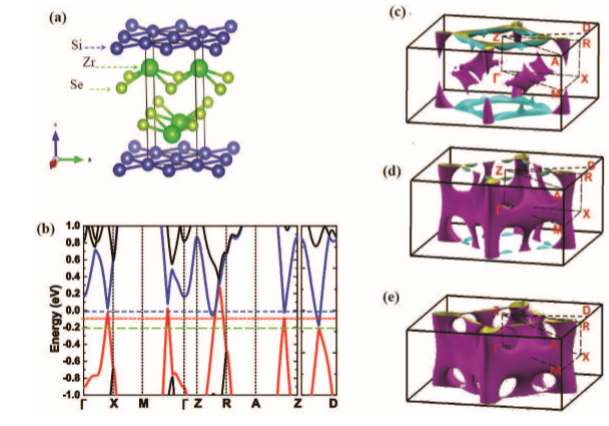Jul 1 2020
A new study has unraveled the exciton instability and physical mechanism of the Lifshitz transition in ZrSiSe, a topology semimetal.
 (a) Crystal structure of ZrSiSe. (b) The first-principles calculated band structure of ZrSiSe with SOC along high symmetry lines. The dashed blue, dotted red, and long dashed green lines label three different Fermi levels corresponding to the cases with temperature T = 5 K (intrinsic case), 102 K, and 106 K, respectively. (c), (d), (e) The three-dimensional Fermi surface with the Fermi energy labeled by the dashed blue, dotted red, and long dashed green lines in (b), respectively. Image Credit: LUO Xuan.
(a) Crystal structure of ZrSiSe. (b) The first-principles calculated band structure of ZrSiSe with SOC along high symmetry lines. The dashed blue, dotted red, and long dashed green lines label three different Fermi levels corresponding to the cases with temperature T = 5 K (intrinsic case), 102 K, and 106 K, respectively. (c), (d), (e) The three-dimensional Fermi surface with the Fermi energy labeled by the dashed blue, dotted red, and long dashed green lines in (b), respectively. Image Credit: LUO Xuan.
The study was conducted by a collaborative team from the Institute of Solid State Physics under Hefei Institutes of Physical Science, Zhejiang University, High Magnetic Field Laboratory of the Hefei Institutes of Physical Science, Beijing Institute of Applied Physics and Computational mathematics, Hamburg University, Ural Federal University, and other institutions.
The study outcomes have been reported in the Physical Review Letters journal.
In condensed matter physics, the topological change of a Fermi surface is described by Lifshitz phase transition. Certain external parameters such as pressure, chemical doping, magnetic field, etc. can induce Lifshitz transition.
The researchers of this study reported a new kind of Lifshitz phase transition in the Dirac semimetal induced by the temperature. In the Dirac semimetal, the transition generally occurs at the nodal point through which Fermi energy passes.
Since the mobility of carriers is high in the vicinity of these nodes, when Fermi energy passes via the nodes, the system can be turned from n (p) to p (n). Thus, the Lifshitz phase transition is, in general, closely associated with the abnormal transport behavior of topological semimetals.
The researchers developed high-quality ZrSiSe single crystal, combined the electric transport under low temperature and magnetic field, and used scanning tunneling spectrum measurement and first-principles calculations to find the Lifshitz phase transition was induced in ZrSiSe by temperature.
Moreover, an analysis of hall conductance using the two-band model revealed that a hole acted as the carrier when ZrSiSe was maintained at a temperature higher than the critical temperature of T = 106 K.
When the temperature was below 106 K, some electronic carriers emerged unexpectedly. A further decrease in temperature led to the electron and hole carriers being very near to compensation at low temperature.
Furthermore, the outcomes of differential conductance spectroscopy were in agreement with the transport results. When combined with the first-principles calculations, it was discovered that the sudden variation in the concentration of carriers arises due to the generation of new electronic pocket as a result of the shift in Fermi energy level caused by temperature reduction.
This confirms that the Lifshitz phase transition was induced by the temperature.
Moreover, the pseudo energy gap structure of “V-type” density of state was noticed close to the Fermi level in the low-temperature scanning tunnel’s differential conductance spectrum. Form the theoretical calculations, it was found that the pseudo-energy gap structure emerged from the exciton instability interaction caused by the electronic correlation effect and the spin-orbit coupling.
This study offered a complete picture of the temperature-induced Lifshitz phase transition effect in ZrSiSe and discovered the exciton instability induced by the correlation effect in the system, thus widening the research direction of nodal semimetals.
This study was financially supported by the National Key R&D Program, the National Nature Science Foundation of China, the Joint Funds of the National Natural Science Foundation of China and the Chinese Academy of Sciences’ Large-Scale Scientific Facility, and the Users with Excellence and Scientific Research Grant of the Hefei Science Center of the Chinese Academy of Sciences.
Journal Reference:
Chen, F. C., et al. (2020) Temperature-Induced Lifshitz Transition and Possible Excitonic Instability in ZrSiSe. Physical Review Letters. doi.org/10.1103/PhysRevLett.124.236601.